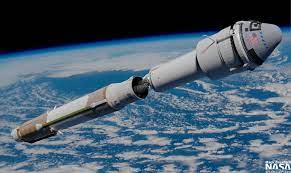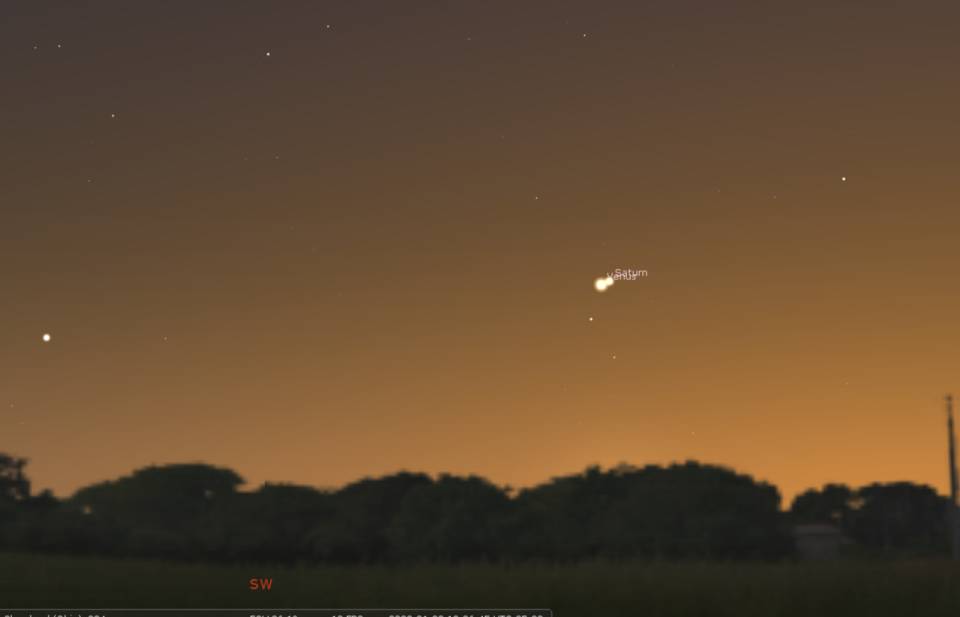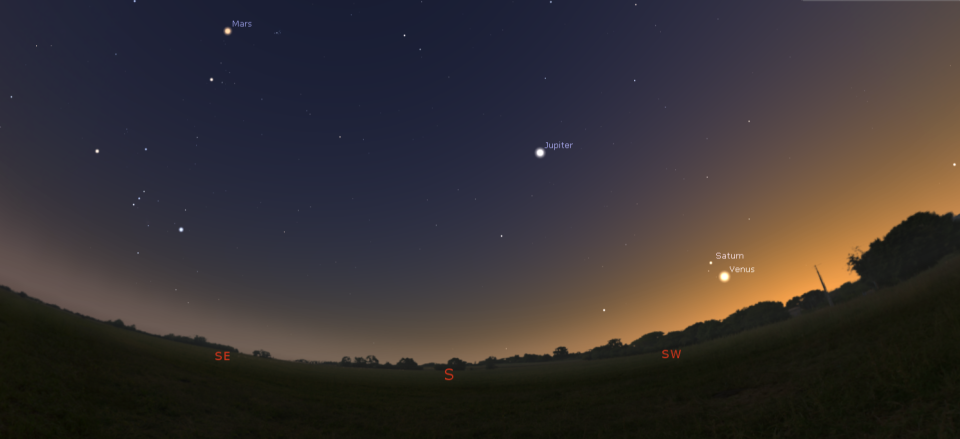Sky Shorts: Space exploration, night sky highlights for 2023

This year has been amazing and historic for space exploration.
The most powerful telescope, the James Webb Space Telescope, successfully deployed and cooled one million miles from Earth. The first incredible images were shared July 12. The return to moon mission, Artemis I, launched Nov. 16, and the uncrewed Orion capsule splashed down Dec. 11. This successful test mission paves the way for astronauts to orbit the moon in 2024. NASA’s SpaceX Crew 3 returned in May; Crew 4 launched in April and returned in October; and Crew 5 launched in October.
Our 2022 celestial highlights included two total lunar eclipses – on May 16 and Nov. 8. We also had a spectacular planet show in the evening sky to close out the year, featuring Venus, Saturn, Jupiter and Mars!
Space exploration highlights for 2023
The European Space Agency’s Jupiter Icy moons Explorer, or JUICE, will make detailed observations of Jupiter and its three ocean-bearing moons – Ganymede, Callisto and Europa. These moons are considered to be potentially habitable. Launch is set for April 2023.
Launched Sept. 8, 2016, NASA’s OSIRIS REx spacecraft obtained a sample of a near-Earth asteroid called Bennu in 2018.
The sample returns to Earth in September 2023. The mission will help scientists discover information on planet and life formation and improve our understanding of asteroids that could impact Earth.
NASA’s Psyche mission has a target launch date in October 2023. Psyche is named after the unique metal asteroid, in the asteroid belt, that it will visit. Psyche appears to be the exposed nickel-iron core of an early planet, a building block of our solar system.
NASA SpaceX Crew 5 returns in March from the International Space Station. Crew 6 launches Feb. 15 and returns in the fall. Crew 7 launches in the fall.
Also headed to the ISS is the first crewed flight of Boeing’s CST-100 Starliner, launching in April 2023. Starliner can carry up to seven passengers but only two will be at the controls for the spring launch, astronauts Barry “Butch” Wilmore and Suni Williams.
Night sky highlights for 2023
March 2 – The two brightest planets in the night sky, Venus and Jupiter will be less than a degree apart.
April 8 – One year until the total solar eclipse.
April 29 – National Astronomy Day.
June 1-2 – Mars passes through the Beehive Star Cluster.
June 12-13 – Venus passes through the Beehive Star Cluster.
June 21 – Venus, Mars and the waxing crescent moon make a tight grouping after sunset.
Aug. 30 – Supermoon. Closest full moon of the year. Also, the blue moon, second full moon in August.
Oct. 14 – Partial Solar Eclipse. Begins at 11:49 a.m. Maximum at 1:09 p.m. with 40% coverage of the sun. Ends at 2:30 pm. Entire eclipse will last 2 hours, 41 minutes. Great dress rehearsal for total solar eclipse on April 8, 2024.

Night Sky for January
Planets and the Moon – Early winter sunsets give us plenty of time to enjoy the fabulous planet show after the sun goes down. Dazzling Venus has returned to the evening sky. Shining at magnitude -3.9, Venus can be found low in the west-southwest one hour after sunset on Jan. 1 and two hours after sunset on Jan. 31. Throughout the month, Venus slides along the ecliptic and meets up with Saturn on Jan. 22 for a very close encounter. The pair will be less than one degree apart and will be in the same field of view through a telescope! On the same night, the very young Moon will be below the pair, very low in the west-southwest. The next evening, the crescent moon will be slightly above the pair. Saturn starts the month twenty degrees high in the southwest, after sunset, at magnitude 0.8. By mid-month, Saturn is 15 degrees high after sunset. By month’s end, Saturn is quickly lost after sunset. Jupiter is brilliant, high in the south-southwest, at magnitude -2.4. Jupiter sets over six hours after sunset on Jan. 1 and around four hours after sunset on Jan. 31. Jupiter will pair up with the crescent Moon on Jan. 25. Bright Mars can be found in Taurus, the Bull, shining at magnitude -1.2. On Jan. 1, Mars will be 70 degrees high in the southern sky, nine degrees east of the beautiful open star cluster, the Pleiades. Mars and the waxing gibbous Moon will be together on Jan. 30. Neptune is located high in the southwest sky, in eastern Aquarius, at magnitude 7.8. Jupiter is eight degrees east, so it is a useful guide to find Neptune with binoculars. On Jan. 24, Neptune will be five degrees above the Moon. Uranus lies in southern Aries at magnitude 5.7. On Jan. 28-29, Uranus will be less than one degree from the gibbous Moon. Binoculars are best for viewing. Mercury heads to the morning sky after Jan. 7 and brightens from magnitude 1.1 on January 15 to 0.0 on Jan. 22. Mercury reaches its greatest western elongation, 25 degrees from the Sun, on Jan. 30. On Jan. 19, the waning crescent Moon is 15 degrees right of Mercury and may be a useful guide.
Constellations:
East – Great star hopping in this part of the sky! Start with the most magnificent picture in our stars, Orion, the Hunter. Look for the three stars in a line, which make up the belt of Orion. The bright red-orange star up and to the left of the belt is Betelgeuse. The bright blue-white star down and to the right of the belt is Rigel. Draw a line up from the belt to a red, orange star, Aldebaran, which is the eye of Taurus, the Bull. The sideways V shape is the face of Taurus. Above Taurus, the small cluster of stars is the Pleiades or Seven Sisters. Making a counterclockwise loop from the Pleiades, the next bright star is Capella. Continuing down, the two stars you see are Gemini, the Twins.
North – The Big Dipper is beginning to swing up on its handle. Following the two stars at the end of the cup to the next bright star, is Polaris, or the North Star. The constellation Cassiopeia is above and to the left of Polaris and resembles the letter “M.”
West – There you will see four stars that form the Great Square of Pegasus.
Binocular Highlights – When facing north, locate the “M” shape of Cassiopeia. From the left point of the “M” shape, scan slowly up to the left. You will see a fuzzy circular shape. That is the Andromeda Galaxy. From the right point of the “M,” scan up slightly. You will come upon the Double Cluster in Perseus. High overhead, you will see the small cluster of stars, the Pleiades or the Seven Sisters. The Pleiades is a beautiful open star cluster. Head to Orion, the Hunter. Scan below the three stars of Orion’s belt. You will see fuzzy area with bright stars. This is the Orion Nebula, a hydrogen gas cloud where new stars are forming.
The peak of the Quadrantid Meteor Shower is Jan. 3.
For further night sky details, maps and audio, visit my website www.starrytrails.com.

Visit the Hoover Price Planetarium
Visit www.mckinleymuseum.org, for show dates and times. Planetarium shows are free with museum admission. The planetarium is located inside the McKinley Presidential Library & Museum, 800 McKinley Monument Drive NW, in Canton. For more information, call the museum at 330-455-7043.
This article originally appeared on The Repository: Sky Shorts: Space exploration, night sky highlights for 2023

